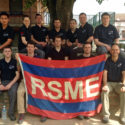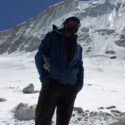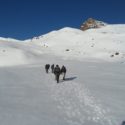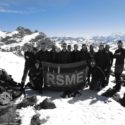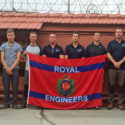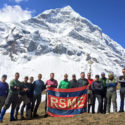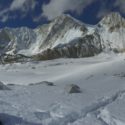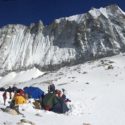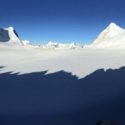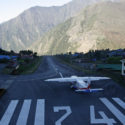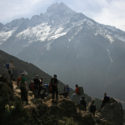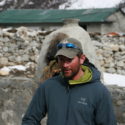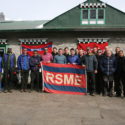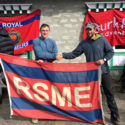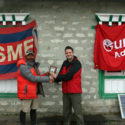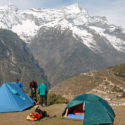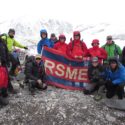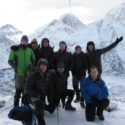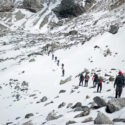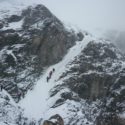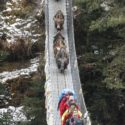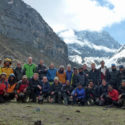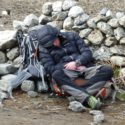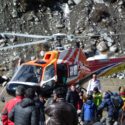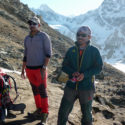Introduction
Maj Andy Gooch
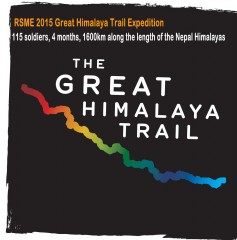 Exercise TIGER THULO TRAVERSE (Ex TTT) set out to trek the 1600km length of the Nepalese Himalayas along a route called the Great Himalaya Trail (GHT). It was to follow in the footsteps of ex-Sapper Captain Doc McKerr who became the first person to trek the route solo, unsupported in 2013 in the incredible time of 66 days. This was to be a more sedate affair, but no less ambitious; 108 Soldiers, Sailors and Airmen from across the Royal School of Military Engineering (RSME) and 7 x Reserve Instructors were to take 4 ½ months to complete the journey as a series of 8 sequential legs, each one led by a Regiment or Wing of the RMSE.
Exercise TIGER THULO TRAVERSE (Ex TTT) set out to trek the 1600km length of the Nepalese Himalayas along a route called the Great Himalaya Trail (GHT). It was to follow in the footsteps of ex-Sapper Captain Doc McKerr who became the first person to trek the route solo, unsupported in 2013 in the incredible time of 66 days. This was to be a more sedate affair, but no less ambitious; 108 Soldiers, Sailors and Airmen from across the Royal School of Military Engineering (RSME) and 7 x Reserve Instructors were to take 4 ½ months to complete the journey as a series of 8 sequential legs, each one led by a Regiment or Wing of the RMSE.
Legs 1 and 2 had great success and all was going well for Leg 3 when the catastrophic earthquake hit Nepal on 25 Apr 15 triggering an avalanche which injured 8 (4 x soldiers and 4 x Nepalese support staff) and tragically killed 2 of the Nepalese support team from Gurkha Adventures, the trekking company that has been involved from the start. This article aims to briefly cover the highs and low of what was achieved before the inevitable decision was made to cancel the remainder of the expedition and to show what can be achieved with forethought and planning.
Planning for the expedition began in September 2013 by first seeking Comdt RSME’s buy-in and that of each of his Commanding Officers. The next hurdle was to secure one of the slots for an AT expedition to Nepal in 2015 and a huge vote of thanks must go to the AT Desk Officers Maj (ret’d)Tony Phinn and Lt Col (ret’d) Dougie Peters in Support Command and all the staff at Adventure Training Group (Army) for their support and encouragement. By late February 2015 all members had been identified and almost 100 were able to attend a 2 day training seminar at Gibraltar Barracks, Minley. With has much set in stone as possible, the Advanced Party of Leg 1 left the UK on 9 March 15 and departed Kathmandu on for the airstrip in the far east of the country at a place called Bhadrapur. This is where the story starts.
Leg 1, 3 RSME Regt. Kanchenjunga Base Camp – Tumlingtar.
Reserve Instructor: Sgt Paul Kelsall 3 Royal Welsh Regiment
The journey to the start of the trek was an experience in itself; a short mountainous flight from Kathmandu to Bhadrapur followed by a very bumpy bus ride to Taplejung before an equally exhilarating 4×4 ride eastwards on some pretty hairy roads was a great start to our 4 week trek. Although we were trekking the GHT in a westwards direction we had a week’s walk eastwards to get to the start point of the trek itself, Kanchenjunga Base Camp (KBC).
The 5 day trek to Lhonak, the final settlement before KBC was long and strenuous with the effects of altitude and the cold being felt by all. The day after reaching Lhonak was an early morning start in order to reach KBC (5143m) by mid-morning and despite all suffering from the effects of altitude, all 14 members of the team made it to the foot of the world’s third highest mountain and the start of the GHT proper.
Having retraced our steps back though Lhonak, we turned west and prepared to cross the Lumbha Samba, (5159m), the highest part of this leg of the expedition. Two days before tackling the pass we were lucky to stay in a village where one of the porter’s sisters lived and she put us up for the night after a miserably wet day. The opportunity to dry out and drink sweet tea was wonderful; a good night’s sleep was definitely required in preparation for the next couple of days.
The day we crossed the Lumbha Samba we had breakfast at 0300hrs and we then didn’t stop for the next 12hrs. The early start was necessary to ensure the day was not spent sinking in the soft snow. An ascent of 1100m over mixed terrain proved difficult in some sections of the trail but all was worth the effort once the pass was reached in the late morning. Now all acclimatised, this walk was much more welcome than KBC; however fatigue had truly started to set in. The descent was not as straightforward as initially thought, with a couple of members taking a slide down the mountain. Thankfully the team all made it safely to their destination that day, Thudam; a small Sherpa town near a river where we attracted quite the audience whilst eating our evening meal!
The group continued west to Hatiya when the decision was made to start the move south to Num. This was after a recce by the porters confirmed the high pass to Makalu was deemed impassable and the lower route to the Base Camp was also unsuitable for a large group due to the going and weather. The more the group descended the more there was to see. Villages appeared more frequently and were noticeably more developed, it was much greener with wildlife and a little easier on exhausted legs. 4×4 taxis were available for the final uphill stretch to Num and the next day to the airhead at Tumlingtar; the first day with phone reception and wifi which saw the end of interaction between the group members!
Leg 2, 1 RSME Regiment. Tumlingtar – Lukla
Leg 2 Overview
The ground covered by Leg 2 was the most technically demanding and toughest section of the GHT. It crosses 2 x 6100m+ passes that lie directly to the South of the World’s 5th highest mountain, Makalu as well as crossing the infamous 5900m Amphu Laptsa Pass that links the Honghu Valley to the Solu Kumbu and the Everest Region. Due to the extreme height and unseasonably bad weather Leg 2 had a difficult time and a number of members of the team were evacuated with severe Acute Mountain Sickness (AMS). Despite this what they achieved was phenomenal and they became the first people this year to make the crossing of the 3 passes this year. Below are some memories of 3 of the youngest members of the Leg 2 team.
LCpl Sam Taylor and Spr Macpherson
Macpherson When we first arrived at Kathmandu, we were all stunned by what the city was like. Motorbikes, little cars and people everywhere, coupled with the background noises; horns and power tools constantly sounding. Following the short journey through the city centre we arrived at British Gurkha Nepal (BGN), which had a completely different atmosphere to the city centre. It was calm with fountains and well-kept gardens and it was very tidy.
Taylor. We flew to Tumlingtar where we would spend our first night before starting our trek with a five hour journey by road into the mountains to the village of Num. The following day the heat and humidity in the jungle was incredible. As we progressed we reached the snow line and having only just broken the 3000m mark a few members of the group came down quickly with altitude sickness resulting in vomiting and some worrying changes in character. However, breaching the snow line in the Himalayas has got to be an experience I won’t forget, partly due to the fact that I was wearing running shorts, trainers and a thermal top because of previously being in jungle conditions. It is fair to say I noticed the cold at that point.
Taylor Early on we had to cross 4 x 4000m+ passes over extremely dangerous terrain and to add to this, bad weather had recently caused a massive snow dump on the mountains above. The snowfall the night before made it very difficult to make out a clear path over the passes. Because of this myself and two other stronger members of the group volunteered to push forward of the main group and cut steps into the snow over the passes. I found this extremely challenging both physically and mentally. I really enjoyed the challenge of the day overall as this was exactly the type of thing I had hoped for on the trail. We all eventually made it to the teahouse and the next morning we woke to find snow leopard tracks around the teahouse.…. A few days later when we set off I felt different from the day before, this was to be the onset of altitude sickness. The first thing I noticed was the difference in my body rather than my mind-set. I felt strong enough to move at a good pace and wanted to, however no matter what I told my body to do I could not take more than just a few steps at a time. The next morning we set off to Makalu Base Camp and the headaches hit me hard. This was the point at which the decision was made to put me on medication as I was starting to retain water. We arrived at Makalu Base Camp to witness the most amazing scenery I have ever seen. Unfortunately this was to be the end of my trek as that night my condition became worse. The following day myself and four other members of the team were evacuated from the mountain by helicopter.
Macpherson: Once we were told that our plan was to make it to Makalu Base Camp, I was excited but nervous in case the altitude was to affect me further. The trek to reach it offered us some incredibly memorable views, however, the headaches and sickness returned to haunt me and after reaching Base Camp and a night’s fitful rest I was told myself and 4 other members of the team would not be carrying on further up the mountain. Initially I was angry because I wanted to complete the task but when I understood the severity of what could have happened in terms of the AMS, I accepted the decisions being made were for our welfare. After a trip by helicopter back to the heat, noise and pollution of Kathmandu we were told that it had been arranged for us to visit Pokhara, the home of Gurkha selection. This was an amazing experience and fascinating to see another area of Nepal. We stayed at another British Gurkha Army camp, which was a lot bigger than the one in Kathmandu.
Taylor Nepal was an amazing experience and one I will hopefully experience again. From the time on the mountain to the time we spent travelling the country, it was definitely an experience of a lifetime. My only regrets are pushing forward of the group and the fall I suffered at the teahouse, I think this combined, cut short my experience. The team were a fantastic group of people and I made some great friends. The Nepali landscape allowed us to experience multiple surroundings and terrains from jungle to snow capped peaks. Nepal has it all and I hope to return in the not so distant future.
Spr Stone continues the story from Makalu Base Camp.
From Makalu Base Camp the rest of the team pushed forward into what seemed like a long white nothingness. We all knew what was ahead though: the hardest part of the trip, including 2 x 6200m passes, the Sherpini Col and West Col and then 2 days after this the Amphu Labsta Pass. The Amphu Labsta is one of the most difficult passes in the Himalayas. and on average only 80 people a year cross it and this year none had done so before us.
The day we crossed the high passes we set off at 2am and were on the move for nearly 20hrs. We crossed deep snow and proceeded to do a 100m abseil down an ice wall in crampons – certainly an experience to remember. Sadly the morning following this we had to evacuate two more members of the team, one due to frostbite and the other due to pulled ligaments in his back. After another memorable day crossing the Amphu Labtsa and eventually meeting in Leg 3 in Dingboche the walk back down to Lukla was a welcome chance to recover our strength and take in the fantastic scenery.
For me the trip has given me an opportunity to see how the Army operates on expeditions as my previous experience was in training. It was great getting to work with senior soldiers and see their approach to the various challenges. The trip has also without doubt given me the opportunity to push myself physically and mentally – further than I thought I would ever be able to go. A good example of this is when we had to do a 13hr day, crossing the Amphu Labsta Pass in snow up to my waist on nothing more than a bowl of porridge, a snickers and a packet of biscuits!
The trip has taught me a huge amount about how much teamwork matters, particularly in a dangerous environment. You really have to look out for your mates on the mountain, as the illnesses you are susceptible to can come on suddenly and can be very dangerous. Learning to check your mates are okay before sorting out your own needs has definitely been a huge learning curve for me.
This trip has had massive ups and downs. For me the worst point of the trip was losing my friends and teammates at Makalu Base Camp. Initially it felt like the support from friendship was lost and the dynamics of the group were altered and it is obviously nice to finish things as a full team. However you then regroup and focus on the next challenge. An unforgettable high point has to be receiving a KFC at 5900m at the high camp before the Amphu Labsta Pass – the ‘Colonel’s Recipe’ has never tasted so good!
Leg 3, Royal Engineers Warfare Wing. Lukla – Last Resort
Reserve Instructors: WO2 Christian Cheshire Northumbria UOTC and Sgt Des Barlow, 170 Infra Sp Engineer Group
This Leg of the GHT set out to traverse the Everest Region of Nepal and cross 3 passes in excess of 5000m and also visit Everest Base Camp itself. For the first part the team was also joined by the overall expedition OIC, 2IC 3 RSME Regt, Maj Andy Gooch, CO 3 RSME Regt, Lt Col J West and CI REWW, Lt Col R Morton.
The flight into Lukla, the gateway to the Solu Khumbu and Everest is renowned for being an exhilarating flight and it did not disappoint. It must be the closest any of the team would get to landing on an aircraft carrier. The first few days trekking gave a good opportunity to shake out and start to appreciate the effects the altitude would play and the team got used to the pace they would need to maintain. After an acclimatisation day in the Sherpa capital of Namche Bazaar the team awoke to find their tents covered in 20cm of snow. Something very rare at such a low altitude (3460m) this late in the season. The team pushed on through the snow to Dingboche (4410m) where they met with Leg 2. Hearing of their adventures the realisation of the team had embarked on started to sink in. Leg 2 passed on their high altitude kit and some top tips before heading south to Lukla with the Exped OIC, CO and CI.
3 days later all the team made it to Gorak Shep in glorious weather and then on to Everest Base Camp (5143m) where the weather came in quickly turning snowy, windy and very cold. These adverse weather conditions meant nobody was keen to hang around at base camp (5346m) after the obligatory team photo. The following day, 10 members of the 14 man team reach the summit of Kala Pattar (5550m) before then turning west, ready to tackle the Cho La (5420m) and Renjo La (5400m). However, at this stage the decision was made to evacuate one member of the team due to worsening AMS symptoms. The descent from the Cho La was difficult and required individuals to wear crampons and helmets due to the steepness of the ice slope while the ascent to the Renjo La proved arduous after a series of long days. The sun made it incredibly hot at times but the view from the top of the Renjo La, across to Everest was spectacular and the best seen so far.
After a rest day in the Sherpa village of Thame the crux of this leg was crossing the 5755m Tashi Laptsa pass and the team did this on 25 Apr 15. They rose at 0030 for a 0200 departure already wearing harnesses as they knew there would be fixed rope sections on the ascent. The ascent was steep throughout but as it was dark it was just a case of following the head torch in front. Towards the top of the pass there were several fixed rope sections as a fall would result in a 300m drop.
The pass was reached at 0630 and the descent began, again involving roped sections. At around 1200 the earthquake struck Nepal which triggered an avalanche engulfing the entire group and sweeping away all equipment. It consisted of mainly hard rock and ice as opposed to powder and it was soon found that 2 of the Gurkha Adventures support team had been killed and there were a further 4 x British and 4 x Nepalese casualties. The injuries included head wounds, a dislocated shoulder, suspected broken ribs and shock. After liaison with the helicopter company and attempting to contact the Embassy the scale of disaster that had engulfed Nepal became clear and the team realised it may be some time before they were rescued. The decision was taken to walk to the nearest village, Na, as despite having casualties the concern was an aftershock might trigger a second avalanche. The walk to Na was extremely strenuous as there was little food and water and the majority of kit had been lost. After a further 10hrs walking the small settlement was reached where the team stayed for the next 72hrs while waiting for rescue before being evacuated to Kathmandu by helicopters.
By the time we arrived back at British Gurkhas Nepal it had been transformed into the operational Hub for the British disaster relief effort so was very busy and the next few days were spent trying to help out around the camp where possible and conduct post trek administration. After re-arranging flights the team returned back to the UK on 1 May 15.
Conclusion
With further earthquakes occurring and the Foreign and Commonwealth Office advising against all but essential travel to Nepal for the time being the decision had to be taken to stop the expedition. Instead, those involved in the GHT turned their attention to raising money for a GHT Memorial Fund to help support the families of those killed supporting us; Aas Bahadur Gurung, a guide on Leg 3 and Roshan Gurung a porter who had trekked with the team from the Kanchenjunga Base Camp. To date approximately £11,000 has been raised.
As awful as this event has been for Nepal and it’s people we must not overlook what was achieved: 45 soldiers from 6 different cap badges, Reserve and Regular, and ranging in age from 18 to 52, 10 of whom had only finished their Army training weeks before leaving the UK, trekked a third of the length of the Nepalese Himalayas in just under 6 weeks. They crossed 8 passes in excess of 5200m and for Leg 2, they became the first people this year to force a way across the 6200m Sherpini Col and West Col beneath Makalu, the world’s 5th highest mountain.
The RSME will return to Nepal in October 2016 to conduct a memorial trek to place commemorative plaques in the villages where Roshan and Aas came from and then complete a trek around Mt Manaslu, the world’s eighth highest mountain.

